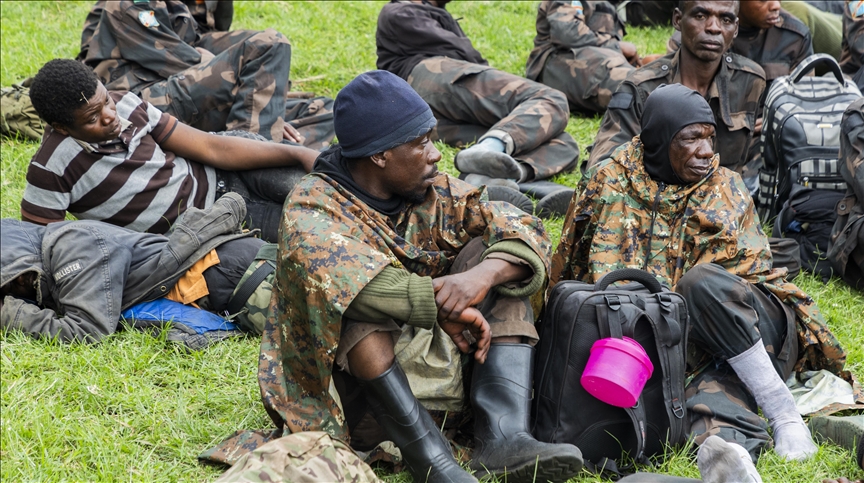FACTBOX - What led to the escalation in the Democratic Republic of Congo?
M23 rebels captured the key city of Goma in the eastern DRC Monday, forcing thousands of civilians to flee in the latest in a series of advances
 Some Democratic Republic of Congo (DRC) army forces, who fled the region due to the clashes crossed into Rwanda through the Corniche border crossing between the DRC and Rwanda, surrender to Rwandan forces in Kigali, Rwanda on January 27, 2025.
Some Democratic Republic of Congo (DRC) army forces, who fled the region due to the clashes crossed into Rwanda through the Corniche border crossing between the DRC and Rwanda, surrender to Rwandan forces in Kigali, Rwanda on January 27, 2025.
- Kinshasa severed ties with Kigali over the conflict, accusing the neighboring country of supporting M23 rebels
- At least 17 peacekeepers and foreign soldiers have been killed so far in conflict, while hundreds of thousands of civilians have been displaced
ISTANBUL
Clashes in the eastern Democratic Republic of Congo (DRC) have escalated this week as rebel fighters continued to advance, capturing a key regional center in North Kivu province, where much of the violence is taking place.
Hundreds of UN staffers and civilians in the area have fled to neighboring Rwanda, a country that the DRC accuses of backing the M23 rebels that claimed to seized the provincial capital Goma.
These developments come amid mounting regional tensions. Congo severed diplomatic ties with Rwanda Sunday as the escalation has left at least 17 peacekeepers and foreign soldiers dead, while displacing more than 400,000 civilians since the beginning of the year.
The rebels' gains triggered violent demonstrations Tuesday near several embassies in Kinshasa, including those of Rwanda, as well as France, the US, Kenya, Uganda, Belgium, Japan, which the protesters accuse these countries of backing the ongoing rebel offensive by supporting Kigali.
Footage on social media shows Congolese troops, some in military uniform, handing over their arms to Rwandan security officers after crossing into the neighboring East African country.
According to UN refugee agency (UNHCR) spokesperson Matthew Saltmarsh, the number of people displaced by the fighting has surged to more than 400,000 this year alone as of Friday.
Rebel offensive on Goma
The M23 group recently stepped up its push into eastern Congo earlier this month, seizing important towns after launching a new offensive.
Renewed clashes began on Jan. 3, with the rebels seizing the town of Masisi over the weekend from Congolese forces and the Wazalendo alliance, a bloc of armed groups loyal to the government.
Amid the surge in violence, Rwanda's President Paul Kagame has dismissed reports, including by UN experts, claiming that his country was lending support to M23.
The conflict has disrupted the delivery of food, medicine, and other humanitarian materials to the conflict-hit areas. Many places remain inaccessible due to the lack of security, leaving displaced people without basic necessities.
In response, the Congolese military launched a counter-offensive, reclaiming key locations in the region, including Ngungu, Bitagata, Ruzirantaka, Lumbishi, Kamatale, and Kabingo.
But this was not enough to quell the rebel's progress, as the M23 rebels seized the eastern town of Minova on Jan. 21, which lies on a critical route to Goma.
The resumption of hostilities has been met with a rising international outcry, including by UN Secretary-General Antonio Guterres, who called M23 to "immediately" cease its offensive and withdraw from all occupied areas.
In another key development in the conflict, rebel forces claimed to have killed Maj. Gen. Peter Chirimwami on Jan. 24, the military administrator of North Kivu, during a visit to the front.
Foreign forces and peacekeepers have not been spared. A total of 17 have been killed, including from Malawi, South Africa, and Uruguay, in clashes with the rebels.
The UN has since announced the temporary relocation of non-essential staff from Goma, citing the deteriorating security situation.
On Jan. 26, the rebels announced the closure of Goma's airspace, claiming that pro-government forces were using the city's airport to load bombs.
Meanwhile, UN peacekeeping chief Jean-Pierre Lacroix called on M23 rebels to end their activities and leave the DRC, speaking virtually at an emergency Security Council meeting.
The rebels had managed penetrate the Munigi quarter on the outskirts of Goma by Sunday, with Bintou Keita, the UN secretary-general’s special representative for the country, saying that Rwandan forces were fighting alongside members of M23.
Separately, Rwanda reiterated its commitment to efforts for a political solution.
Other countries in the region have also gotten involved, with Kenyan President William Ruto, who chairs the East African Community (EAC), announcing that the bloc would convene an extraordinary summit to tackle the growing conflict.
How did the conflict get here?
For nearly three decades, the eastern DRC has been plagued by insecurity, with over 100 armed groups fighting for control of its mineral-rich territories.
The relentless violence has displaced millions, forcing thousands to live in camps across the most conflict-affected provinces, North Kivu and neighboring Ituri.
Among these groups, M23 traces its origins to the National Congress for the Defense of the People (CNDP), a rebel faction that signed a peace deal with the Congolese government on March 23, 2009. As part of the agreement, CNDP fighters were integrated into the national army.
However, in April 2012, a group of former CNDP rebels — now in the military — broke away, accusing the government of failing to uphold the agreement.
They formed the March 23 Movement, or M23, taking their name from the date of the peace deal. The group, made up of army deserters, claims to fight for the rights of the Tutsi minority in eastern Congo.
In an initial rapid advance, the group, captured Goma in late 2012. But facing a major counteroffensive by the Congolese army and UN peacekeepers, they suffered heavy losses.
By mid-December the next year, M23 and the Kinshasa government had reached a new agreement, bringing an end to the armed rebellion. The group pledged to pursue its goals through political means, and many of its fighters fled to Uganda and Rwanda.
After nearly a decade of dormancy, M23 resurfaced in 2021, launching a fresh offensive in North Kivu. By 2022, the rebels had seized key towns and advanced toward Goma once again, reigniting tensions between Congo and Rwanda.
Kinshasa, along with the UN and Western governments, has accused Rwanda of backing M23 — a claim Kigali has consistently denied.
Anadolu Agency website contains only a portion of the news stories offered to subscribers in the AA News Broadcasting System (HAS), and in summarized form. Please contact us for subscription options.







